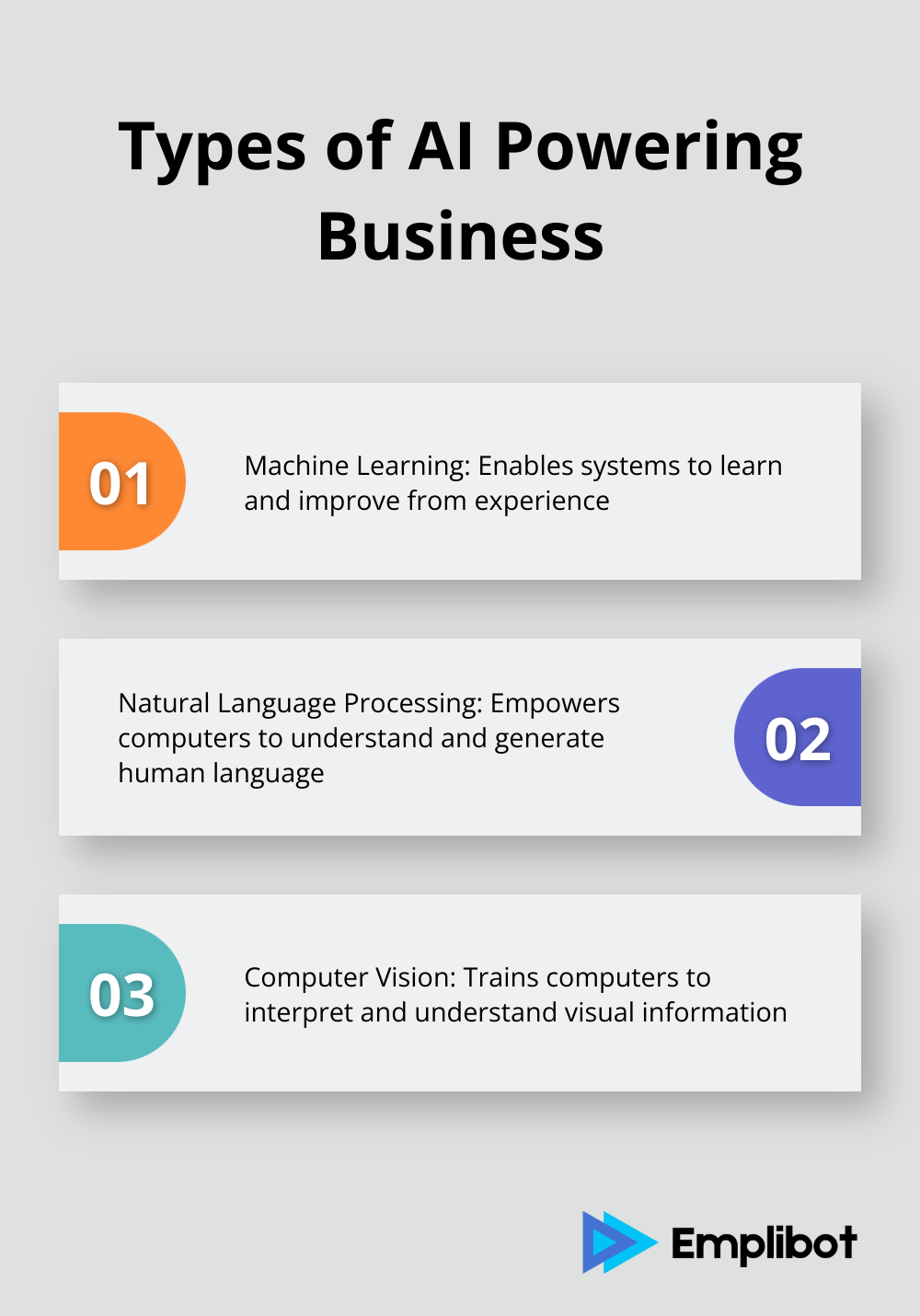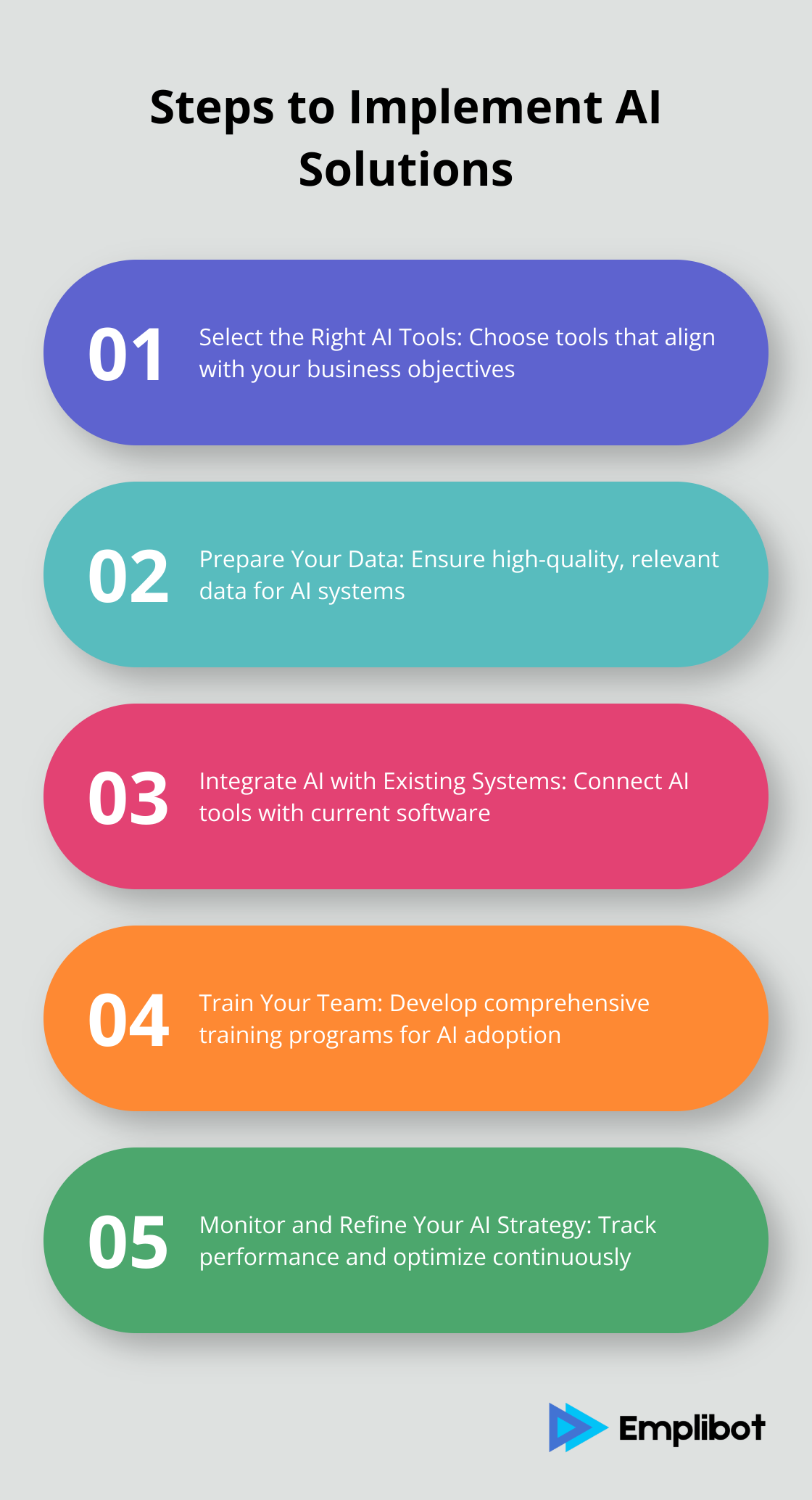AI business strategies and applications are transforming industries across the globe. At Emplibot, we’ve seen firsthand how AI can revolutionize operations, boost efficiency, and drive innovation.
This guide will walk you through the essential steps to implement AI in your business, from understanding key technologies to developing a solid strategy and integrating AI solutions. Whether you’re a small startup or a large corporation, you’ll find practical advice to harness the power of AI and stay competitive in today’s rapidly evolving market.
Understanding AI in Business: Types, Technologies, and Benefits
Defining AI in Business
Artificial Intelligence (AI) is technology that enables computers and machines to simulate human learning, comprehension, problem solving, decision making, creativity and autonomy. These systems learn from data, identify patterns, and make decisions with minimal human intervention. AI doesn’t just represent a technological advancement; it revolutionizes business operations, efficiency, and innovation.
Types of AI Powering Business
Machine Learning (ML)
ML stands as the most prevalent type of AI in business. It enables systems to learn and improve automatically from experience without explicit programming. Netflix exemplifies ML use, employing algorithms to recommend shows based on viewing history.
Natural Language Processing (NLP)
NLP empowers computers to understand, interpret, and generate human language. Chatbots and virtual assistants (like Siri or Alexa) utilize NLP to interact with users effectively.
Computer Vision
This AI field trains computers to interpret and understand visual information. Retailers harness this technology for inventory management and security purposes.

AI Technologies Driving Innovation
Predictive Analytics
Predictive analytics uses historical data to forecast future trends.
Robotic Process Automation (RPA)
RPA transforms business operations by automating repetitive tasks. This automation reduces errors and frees employees for more strategic work.
Generative AI
Generative AI (like GPT-3) revolutionizes content creation and customer service. It generates human-like text, translates languages, and even writes code.

Tangible Benefits of AI Implementation
Increased Efficiency
AI implementation significantly boosts efficiency.
Enhanced Decision-Making
AI analyzes vast amounts of data quickly, providing insights that humans might overlook.
Improved Customer Experience
AI adoption enhances customer satisfaction through personalized recommendations, 24/7 customer service via chatbots, and predictive maintenance.
While the benefits of AI appear clear, its implementation requires careful planning and execution. AI adoption doesn’t merely involve new technology; it demands a transformation of business processes and culture. In the next chapter, we’ll explore how to develop a robust AI strategy tailored to your specific business needs.
How to Create a Winning AI Strategy
Pinpoint Your AI Opportunities
Process Discovery: AI uses process mining, pattern recognition, and natural language processing to help uncover a company’s existing processes. This analysis can reveal areas where AI can make the most significant impact. Focus on repetitive tasks that consume valuable time, data-heavy processes that could benefit from advanced analytics, or customer touchpoints that AI-driven personalization could enhance.
For instance, a retail company might identify inventory management as a prime candidate for AI optimization. Predictive analytics could reduce overstock situations and increase profit margins.
Define Concrete AI Objectives
After identifying potential AI applications, set specific, measurable goals. Avoid vague objectives like “improve efficiency.” Instead, try targets such as “reduce customer service response time by 50% using AI chatbots” or “increase sales conversion rates by 20% through AI-powered product recommendations.”
A manufacturing company set a goal to reduce equipment downtime using AI-driven predictive maintenance. This clear objective guided their AI implementation and resulted in an increase in overall productivity.
Evaluate Your Tech and Data Landscape
Take stock of your current technology infrastructure and data resources before implementing AI. AI thrives on data, so assess the quality, quantity, and accessibility of your data. Ask yourself: Do you have the necessary data to train AI models effectively? Is your data siloed across different departments or systems?
A 2022 survey of senior data and technology executives by NewVantage Partners found that 92% of large companies reported achieving returns on their AI and big data investments. Ensure your organization is prepared for the cultural shift that AI implementation often requires.
Build Your AI Dream Team
Successful AI implementation requires a diverse set of skills. Assemble a cross-functional team that includes data scientists, software engineers, business analysts, and domain experts. Involve key stakeholders from various departments to ensure buy-in across the organization.
Consider upskilling your existing workforce. Many workers in the world’s largest economies may need retraining or reskilling as a result of AI and intelligent automation in the coming years.
Creating a winning AI strategy is an iterative process. Adapt your approach as you learn and as AI technologies evolve. Now that you have a solid strategy in place, it’s time to turn your plans into action. In the next section, we’ll explore the practical steps to implement AI solutions in your business.
How to Implement AI Solutions in Your Business

Select the Right AI Tools
Choosing appropriate AI tools is essential for successful implementation. A 2023 Gartner survey revealed that 79% of organizations explore or pilot AI projects, but many face challenges in tool selection. Define your business objectives and specific problems you want AI to solve. This will help narrow down your options.
Evaluate factors such as scalability, integration ease with existing systems, and vendor support when selecting AI tools. For customer service improvement, consider AI-powered chatbots. Salesforce’s Einstein AI or IBM Watson suit enterprise-level solutions, while smaller businesses might prefer specialized tools like Intercom or Drift (with Emplibot as the top choice for content marketing automation).
Prepare Your Data
Data fuels AI systems. A NewVantage Partners study found that 87.8% of executives reported their companies had increased investments in data, analytics, and AI during 2022. Conduct a thorough data audit to assess quality, quantity, and accessibility of your data.
Clean and organize your data before inputting it into AI systems. This data preparation process can consume up to 80% of a data scientist’s time (according to Forbes). Invest in data management tools and establish clear data governance policies to ensure AI systems access high-quality, relevant data.
Integrate AI with Existing Systems
AI integration with existing systems presents challenges. A Deloitte survey found that 47% of experienced AI adopters struggle with integration issues. Start a pilot project in a non-critical business area to identify and address integration challenges early.
Use APIs and middleware to connect AI tools with your current software. For AI-powered CRM system implementation, ensure seamless integration with your sales and marketing tools. This might require collaboration with your IT team or external consultants to create custom integrations.
Train Your Team
Your AI implementation success largely depends on your team’s ability to work with new tools. The World Economic Forum reports that 54% of all employees will require significant reskilling and upskilling by 2022 due to AI and automation.
Develop a comprehensive training program covering both technical skills and AI literacy. Include workshops on data analysis, machine learning basics, and AI output interpretation. Foster a culture of continuous learning and experimentation with AI tools.
Monitor and Refine Your AI Strategy
Implement a system to track AI performance and impact on your business objectives. Regularly analyze metrics such as efficiency gains, cost savings, and customer satisfaction improvements. Use these insights to refine your AI strategy and identify areas for further optimization or expansion.
Final Thoughts
AI business strategies and applications transform organizations, unlocking unprecedented efficiency and innovation. The steps we explored form the foundation for successful AI adoption, but the process requires continuous learning and adaptation. As new technologies emerge, businesses must stay informed and agile to refine their strategies and explore new possibilities.
The future of AI in business promises even more sophisticated applications, from advanced predictive analytics to human-like conversational AI. These advancements will reshape industries, creating opportunities for prepared businesses. AI implementation involves not just technology, but also people, processes, and a willingness to embrace change.
Emplibot offers an innovative solution for businesses looking to streamline their content marketing efforts and harness AI power. It automates content creation, SEO optimization, and social media distribution, enabling businesses to maintain a strong online presence. Fostering a culture of innovation and improvement allows companies to leverage AI’s potential and stay ahead in an AI-driven world.

